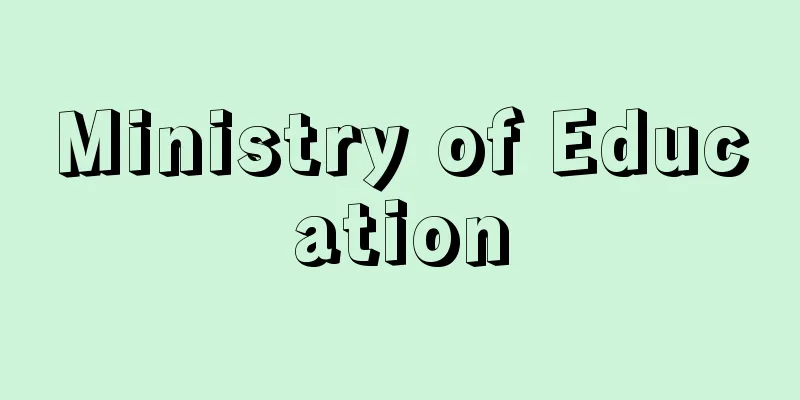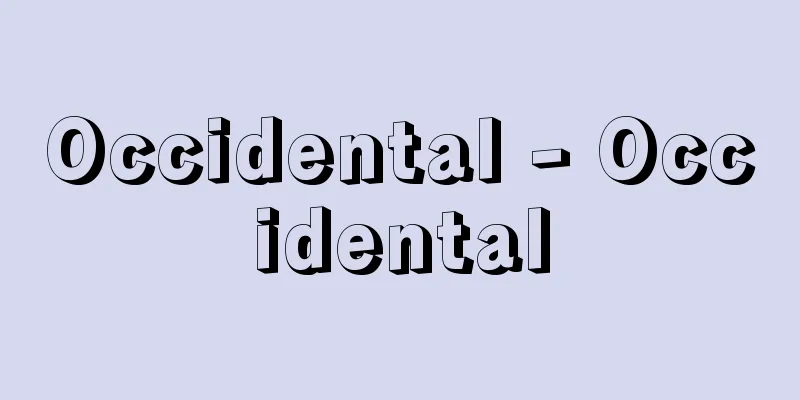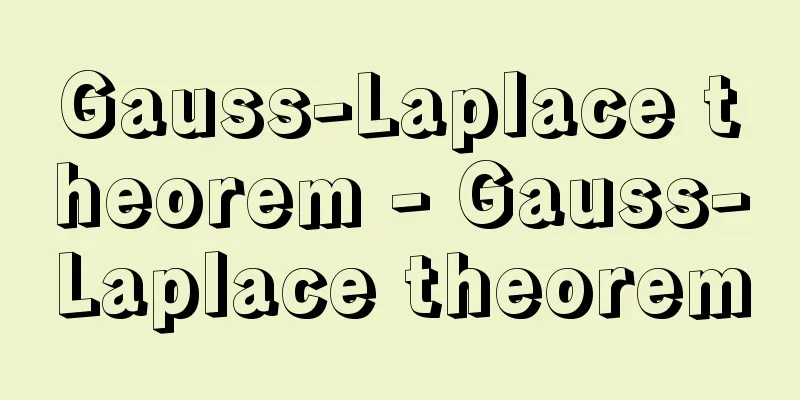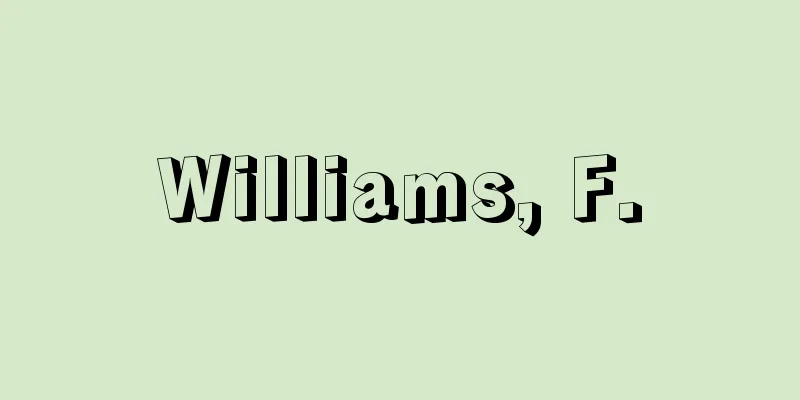Ministry of Education

|
A national administrative agency established by the Ministry of Education Establishment Act based on the National Government Organization Act (Act No. 120 of 1948). Its mission was to promote and disseminate school education, social education, academics, and culture, and it was responsible for the integrated execution of national administrative affairs related to these matters and religion. In January 2001, it was merged with the Science and Technology Agency to become the Ministry of Education, Culture, Sports, Science and Technology. [Toshiro Fuka and Kengo Yamada] HistoryThe Ministry of Education was established in 1871 (Meiji 4) by a proclamation from the Dajokan as an institution solely responsible for educational administration, and developed a modern school system. The Ministry of Education, whose organization and authority were established by the Ministry of Education Ordinance (1886) as part of the Ministry of Education Ordinance, had enormous authority as a centralized central educational administrative institution, and exercised national control over school education and social education in terms of both educational content and administrative supervision. As seen in the militaristic educational policy during wartime, education was considered a means of indoctrination based on the Imperial Rescript on Education's ideology of "loyalty to the Emperor and patriotism." The reforms after World War II clarified the new organization and the duties, mainly of guidance and advice, as a central educational administrative institution suitable for promoting the democratization of education after the war, in accordance with the principles of educational autonomy and local autonomy as ideals. However, the hollowing out of the basic principles embodied in the Constitution and Fundamental Law of Education (such as the implementation of textbook certification and the appointed Board of Education system) and the strengthening of the Ministry of Education's authority were seen as problems. [Toshiro Fuka and Kengo Yamada] Organization and FunctionsIn addition to the Minister's Secretariat, the Ministry had six internal bureaus: the Elementary and Secondary Education Bureau, the Education Assistance Bureau, the Higher Education Bureau, the International Academic Bureau, the Lifelong Learning Bureau, and the Physical Education Bureau. Under the jurisdiction of the Minister of Education, in addition to national schools, there were special institutions such as the Japanese National Commission for UNESCO and the Japan Academy, and facilities and organizations such as the National Institute of Education, the National Institute of Special Education, the National Museum of Nature and Science, and the National Astronomical Observatory. In addition, various councils were established, such as the Central Council for Education, the Council for Science Education and Industrial Education, the Curriculum Council, and the Textbook Examination Research Council. The Elementary and Secondary Education Bureau was responsible for planning and providing assistance for the promotion of elementary and secondary education, setting standards for elementary and secondary education, and the examination of textbooks, while the Education Assistance Bureau was responsible for planning systems related to local educational administration, and for providing guidance, advice, and recommendations regarding the organization and general management of local educational administration. The Higher Education Bureau was responsible for matters such as approval of the establishment and abolition of universities and technical colleges, setting standards for university education and higher technical education, and approving and certifying school corporations, the competent authority of which was the Minister of Education. The Academic and International Bureau was responsible for planning, providing assistance and advice on the promotion of academics, as well as matters related to international exchange relating to the promotion and dissemination of education, academics, and culture. The Lifelong Learning Bureau was responsible for planning, providing assistance and advice on the promotion of social education, and the Physical Education Bureau was responsible for planning and guidance on the promotion and improvement of physical education, school health, and school lunches. Facilities and organizations included national universities and other national schools, the National Museum of Nature and Science, the Agency for Cultural Affairs as an external bureau, and the Japan Academy as a special institution. After 2001, the main functions of the Minister's Secretariat were taken over by the Minister's Secretariat of the Ministry of Education, Culture, Sports, Science and Technology, and the Lifelong Learning Bureau, together with some of the organizations of the Minister's Secretariat, was taken over by the Lifelong Learning Policy Bureau and the Sports and Youth Bureau of the Ministry of Education, Culture, Sports, Science and Technology. In addition, the Elementary and Secondary Education Bureau and the Educational Assistance Bureau were merged and reorganized into the Elementary and Secondary Education Bureau. The Higher Education Bureau was taken over by the Higher Education Bureau of the Ministry of Education, Culture, Sports, Science and Technology. The Academic International Bureau was taken over by the Science and Technology Policy Bureau, Research Promotion Bureau, and Higher Education Bureau of the Ministry of Education, Culture, Sports, Science and Technology, and the Physical Education Bureau was taken over by the Sports and Youth Bureau of the Ministry of Education, Culture, Sports, Science and Technology. National schools and other facilities and institutions, as well as special institutions such as the Japan Academy, were taken over by their respective Ministry of Education, Culture, Sports, Science and Technology, and the Agency for Cultural Affairs was taken over as an external bureau of the Ministry of Education, Culture, Sports, Science and Technology. [Toshiro Fuka and Kengo Yamada] [Reference items] | | | | | , Culture, Sports,The office building was located in Takehira-cho, Kojimachi-ku (currently Hitotsubashi, Chiyoda-ku, Tokyo). "Photographic Collection of Scenic Places and Historic Sites of Japan, Based on National Elementary School Textbooks, Heaven" (1912, Meiji 45), National Diet Library . Ministry of Education (Meiji Period) Source: Shogakukan Encyclopedia Nipponica About Encyclopedia Nipponica Information | Legend |
|
国家行政組織法(昭和23年法律120号)に基づき、文部省設置法によって設置された国の行政機関。学校教育、社会教育、学術および文化の振興および普及を図ることを任務とし、これらの事項および宗教に関する国の行政事務を一体的に遂行する責任を負っていた。2001年(平成13)1月の中央省庁再編で、科学技術庁と統合して文部科学省となった。 [福家俊朗・山田健吾] 沿革もっぱら教育行政を担当する機関として1871年(明治4)に太政官布告により設置され、近代的な学校制度を整備していった。各省官制の一部としての文部省官制(1886)によってその組織および権限が整備された文部省は、中央集権的な中央教育行政機関としてその権限は絶大であり、学校教育・社会教育の国家統制を教育内容・監督行政の両側面から行った。そこでは、戦時における軍国主義的教育政策にみられるように、教育は、教育勅語の「忠君愛国」イデオロギーに基づく国民教化のための手段とみなされていた。第二次世界大戦後の改革により、理念としての教育の自主性および地方自治の原理に従って、戦後教育の民主化を推進するにふさわしい中央教育行政機構としてその新しい組織と指導・助言を中心とした任務が明確化されたが、憲法・教育基本法制が体現するこの基本理念の空洞化現象(教科書検定・任命教育委員会制の実施等)や文部省の権限強化が問題視されていた。 [福家俊朗・山田健吾] 組織と機能本省には内部部局として大臣官房のほか、初等中等教育局、教育助成局、高等教育局、学術国際局、生涯学習局、体育局の6局が置かれていた。文部大臣の所轄の下に、国立学校のほか、特別の機関として日本ユネスコ国内委員会や日本学士院が置かれ、施設等機関として、国立教育研究所、国立特殊教育総合研究所、国立科学博物館、国立天文台などが置かれていた。また、中央教育審議会、理科教育及び産業教育審議会、教育課程審議会、教科用図書検定調査審議会などの各種審議会が置かれた。初等中等教育局は、初等中等教育の振興に関し、企画し、および援助を与えること、初等中等教育の基準の設定に関すること、および教科書の検定に関すること等を担当し、教育助成局は、地方教育行政に関する制度について企画し、ならびに地方教育行政の組織および一般的運営に関し、指導・助言および勧告を与えること等の事務を担当した。高等教育局は、大学および高等専門学校の設置、廃止の認可をはじめ、大学教育および高等専門教育の基準設定、文部大臣がその所轄庁である学校法人の認可・認定などの事務を担当した。学術国際局は、学術の振興に関し、企画し、および援助と助言を与えることをはじめ、教育、学術または文化の振興および普及にかかる国際交流に関する事務を担当し、生涯学習局は、社会教育の振興に関し、企画し、および援助と助言を与えること、体育局は、体育、学校保健、学校給食の普及充実などの企画・指導などの事務を担当した。施設等機関として国立大学をはじめとする国立学校や国立科学博物館などが、外局として文化庁が、特別の機関として日本学士院などが置かれていた。 2001年以降、内部部局に関しては、大臣官房の主要な機能は、文部科学省の大臣官房に引き継がれ、生涯学習局については大臣官房の一部の組織とともに、文部科学省の生涯学習政策局やスポーツ・青少年局に引き継がれ、また、初等中等教育局と教育助成局が統合され初等中等教育局に再編された。高等教育局については文部科学省の高等教育局にそのまま引き継がれた。学術国際局については文部科学省の科学技術・学術政策局、研究振興局、高等教育局などに、体育局については文部科学省のスポーツ・青少年局に引き継がれた。国立学校等の施設等機関や日本学士院等の特別の機関は、それぞれ文部科学省に引き継がれ、文化庁は文部科学省の外局としてそのまま引き継がれた。 [福家俊朗・山田健吾] [参照項目] | | | | | |麹町区竹平町(現在の東京都千代田区一ツ橋)にあった庁舎。『日本名勝旧蹟産業写真集 国定小学校教科書準拠 天』(1912年〈明治45〉)国立国会図書館所蔵"> 文部省(明治時代) 出典 小学館 日本大百科全書(ニッポニカ)日本大百科全書(ニッポニカ)について 情報 | 凡例 |
<<: Ministry of Education magazine
>>: Montfort, Simon de, Earl of Leicester
Recommend
Boyi and Shuqi (English spelling)
A wise man from China at the end of the Shang dyna...
Ghulam (English spelling) ghulām
Arabic for a boy or a servant, especially a slave ...
International Airlines
This refers to air transport operations that inclu...
"Flower-filled Nightingale"
...a substance that has the property of being use...
elektron
…Banknote issuance system [Hidenari Yoshizawa] [H...
Awayuki tofu - Awayuki tofu
〘Noun〙① A special tofu that melts instantly on the...
ASI
Aluminium saturation index. See 4.11.1. Source: As...
Spoiler - spoiler (English spelling)
A plate hinged to the upper surface of the wing o...
Asano Katori - Asano Katori
Year of death: 11th June 10th Jowa (11th July 843)...
Prize advertising
Advertisements that set certain conditions and ap...
Nucleohisto
... refers to a complex formed in a cell by the b...
Pseudo-dementia - Kaseichiho
...also called pseudodementia. Hysterical dementi...
Aeschynanthus lobbianus (English spelling) Aeschynanthuslobbianus
… [Kenzo Fujiwara]. … *Some of the terminology th...
Civil government - Bunchiseiji
The political system of the shogunate in the mid-E...
Union of Utrecht (English: Unie van Utrecht) Dutch
An alliance of seven northern Dutch provinces for...
![Kawanabe [town] - Kawanabe](/upload/images/67cb46b091c62.webp)








